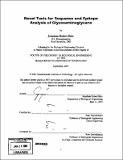| dc.contributor.advisor | Ram Sasisekharan. | en_US |
| dc.contributor.author | Behr, Jonathan Robert | en_US |
| dc.contributor.other | Massachusetts Institute of Technology. Biological Engineering Division. | en_US |
| dc.date.accessioned | 2008-09-03T15:30:15Z | |
| dc.date.available | 2008-09-03T15:30:15Z | |
| dc.date.copyright | 2007 | en_US |
| dc.date.issued | 2007 | en_US |
| dc.identifier.uri | http://hdl.handle.net/1721.1/42383 | |
| dc.description | Thesis (Ph. D.)--Massachusetts Institute of Technology, Biological Engineering Division, 2007. | en_US |
| dc.description | Includes bibliographical references. | en_US |
| dc.description.abstract | Our understanding of glycosaminoglycan (GAG) biology has been limited by a lack of sensitive and efficient analytical tools designed to deal with these complex molecules. GAGs are heterogeneous and often sulfated linear polys accharides found throughout the extracellular environment, and available to researchers only in limited mixtures. A series of sensitive label-free analytical tools were developed to provide sequence information and to quantify whole epitopes from GAG mixtures. Three complementary sets of tools were developed to provide GAG sequence information. Two novel exolytic sulfatases from Flavobacterium heparinum that degrade heparan/heparan sulfate glycosaminoglycans (HSGAGs) were cloned and characterized. These exolytic enzymes enabled the exo-sequencing of a HSGAG oligosaccharide. Phenylboronic acids (PBAs) were specifically reacted with unsulfated chondroitin sulfate (CS) disaccharides from within a larger mixture. The resulting cyclic esters were easily detected in mass spectrometry (MS) using the distinct isotopic abundance of boron. Electrospray ionization tandem mass spectrometry (ESI-MSn) was employed to determine the fragmentation patterns of HSGAG disaccharides. These patterns were used to quantify relative amounts of isomeric disaccharides in a mixture. Fragmentation information is valuable for building methods for oligosaccharide sequencing, and the general method can be applied to quantify any isomers using MSn. Three other tools were developed to quantify GAG epitopes. Two microfluidic devices were characterized as HSGAG sensors. Sensors were functionalized either with protamine to quantify total HSGAGs or with antithrombin-III (AT-III) to quantify a specific anticoagulant epitope. | en_US |
| dc.description.abstract | (cont.) A charge sensitive silicon field effect sensor accurately quantified clinically relevant anticoagulants including low molecular weight heparins (LMWH), even out of serum. A mass sensitive suspended microchannel resonator (SMR) measured the same clinically relevant HSGAGs. When these two sensors were compared, the SMR proved more robust and versatile. The SMR signal is more stable, it can be reused ad infinitum, and surface modifications can be automated and monitored. The field effect sensor provided an advantage in selectivity by preferentially detecting highly charged HSGAGs instead of any massive, non-specifically bound proteins. Lastly, anti-HSGAG single chain variable fragments (scFv) were evolved using yeast surface display towards generating antibodies for HSGAG epitope sensing and clinical GAG neutralization. | en_US |
| dc.description.statementofresponsibility | by Jonathan Robert Behr. | en_US |
| dc.format.extent | 243 p. | en_US |
| dc.language.iso | eng | en_US |
| dc.publisher | Massachusetts Institute of Technology | en_US |
| dc.rights | MIT theses are protected by copyright. They may be viewed, downloaded, or printed from this source but further reproduction or distribution in any format is prohibited without written permission. | en_US |
| dc.rights.uri | http://dspace.mit.edu/handle/1721.1/7582 | en_US |
| dc.subject | Biological Engineering Division. | en_US |
| dc.title | Novel tools for sequence and epitope analysis of glycosaminoglycans | en_US |
| dc.type | Thesis | en_US |
| dc.description.degree | Ph.D. | en_US |
| dc.contributor.department | Massachusetts Institute of Technology. Department of Biological Engineering | |
| dc.identifier.oclc | 234477322 | en_US |

